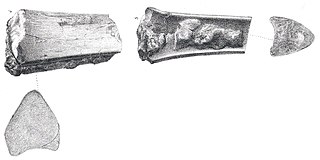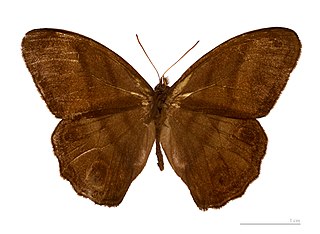
Pterodactylus is an extinct genus of pterosaurs. It is thought to contain only a single species, Pterodactylus antiquus, which was the first pterosaur to be named and identified as a flying reptile and one of the first prehistoric reptiles to ever be discovered.

Pteranodon ; from Ancient Greek πτερόν and ἀνόδων is a genus of pterosaur that included some of the largest known flying reptiles, with P. longiceps having a wingspan of over 6 m (20 ft). They lived during the late Cretaceous geological period of North America in present-day Kansas, Nebraska, Wyoming, South Dakota and Alabama. More fossil specimens of Pteranodon have been found than any other pterosaur, with about 1,200 specimens known to science, many of them well preserved with nearly complete skulls and articulated skeletons. It was an important part of the animal community in the Western Interior Seaway.

In Greek and Roman mythology, a harpy is a half-human and half-bird, often believed to be a personification of storm winds. They feature in Homeric poems.
In ancient Greek religion and mythology, Pluto was the ruler of the Greek underworld. The earlier name for the god was Hades, which became more common as the name of the underworld itself. Pluto represents a more positive concept of the god who presides over the afterlife. Ploutōn was frequently conflated with Ploûtos, the Greek god of wealth, because mineral wealth was found underground, and because as a chthonic god Pluto ruled the deep earth that contained the seeds necessary for a bountiful harvest. The name Ploutōn came into widespread usage with the Eleusinian Mysteries, in which Pluto was venerated as both a stern ruler and a loving husband to Persephone. The couple received souls in the afterlife and are invoked together in religious inscriptions, being referred to as Plouton and as Kore respectively. Hades, by contrast, had few temples and religious practices associated with him, and he is portrayed as the dark and violent abductor of Persephone.

The harpy eagle is a neotropical species of eagle. It is also called the American harpy eagle to distinguish it from the Papuan eagle, which is sometimes known as the New Guinea harpy eagle or Papuan harpy eagle. It is the largest and most powerful bird of prey found throughout its range, and among the largest extant species of eagles in the world. It usually inhabits tropical lowland rainforests in the upper (emergent) canopy layer. Destruction of its natural habitat has caused it to vanish from many parts of its former range, and it is nearly extirpated from much of Central America. In Brazil, the harpy eagle is also known as royal-hawk. The genus Harpia, together with Harpyopsis and Morphnus, form the subfamily Harpiinae.

Harpymimus is a basal ornithomimosaurian theropod dinosaur from the Early Cretaceous Period of what is now Mongolia. Unlike later, more derived ornithomimosaurs, Harpymimus still possessed teeth, although they appear to have been restricted to the dentary of the lower jaw.

Ornithocheirus is a pterosaur genus known from fragmentary fossil remains uncovered from sediments in the United Kingdom and possibly Morocco.

The Chaco eagle or crowned solitary eagle, is an endangered bird of prey from eastern and central South America. Typically it is known simply as the crowned eagle which leads to potential confusion with the African Stephanoaetus coronatus. Due to its rarity, not much is known about its biology or population.

Ornithostoma is a genus of pterodactyloid pterosaur that lived during the Early Cretaceous period of Europe, around 110 million years ago. Ornithostoma was once thought to have been a senior synonym of the pteranodontid Pteranodon due to its toothless anatomy and prior naming.

Hierodula is a genus of praying mantids in the tribe Hierodulini, found throughout Asia. Many species are referred to by the common name giant Asian mantis because of their large size compared to other mantids. Their large size and vibrant coloration make Hierodula mantids popular in the pet trade. Some widespread species include H. membranacea and H. patellifera; however this has been considered a 'catch all' genus and is currently subject to review. In 2020, three species were moved to a new genus, Titanodula.
Hierodula harpyia is a species of praying mantis in the family Mantidae.

Harpyia milhauseri, the tawny prominent, is a moth of the family Notodontidae. The species was first described by Johan Christian Fabricius in 1775. It is mainly found in central Europe.

Dicranoptycha is a genus of crane fly in the family Limoniidae.

Harpyia longipennis is a moth in the family Notodontidae. It is found in south-east Asia, including India and Thailand.

Pteranodontoidea is an extinct clade of ornithocheiroid pterosaurs from the Early to Late Cretaceous of Asia, Africa, Europe, North America and South America. It was named by Alexander Wilhelm Armin Kellner in 1996. In 2003, Kellner defined the clade as a node-based taxon consisting of the last common ancestor of Anhanguera, Pteranodon and all its descendants. The clade Ornithocheiroidea is sometimes considered to be the senior synonym of Pteranodontoidea, however it depends on its definition. Brian Andres in his analyses, converts Ornithocheiroidea using the definition of Kellner (2003) to avoid this synonymy.

Magneuptychia is a genus of satyrid butterflies found in the Neotropical realm.
Bato is an Illyrian name.
This page is based on this
Wikipedia article Text is available under the
CC BY-SA 4.0 license; additional terms may apply.
Images, videos and audio are available under their respective licenses.














